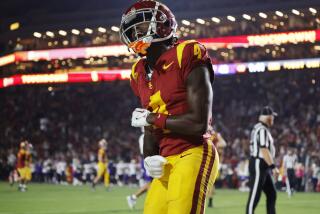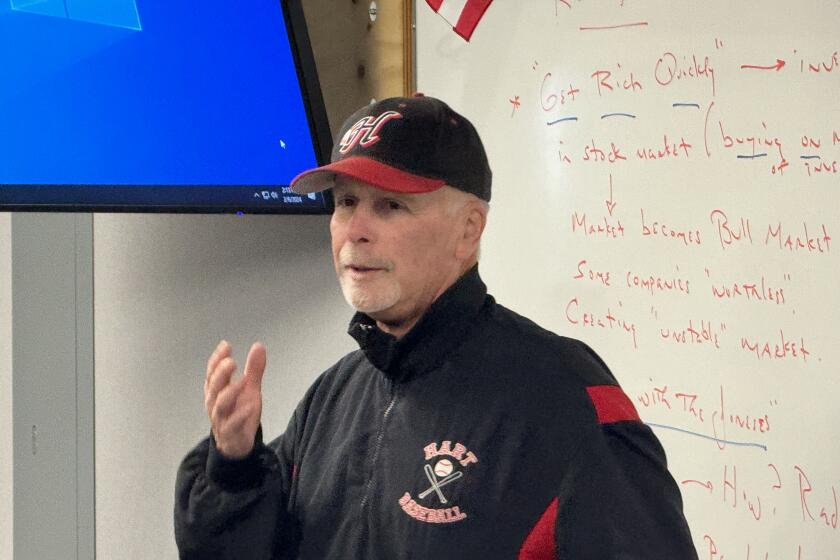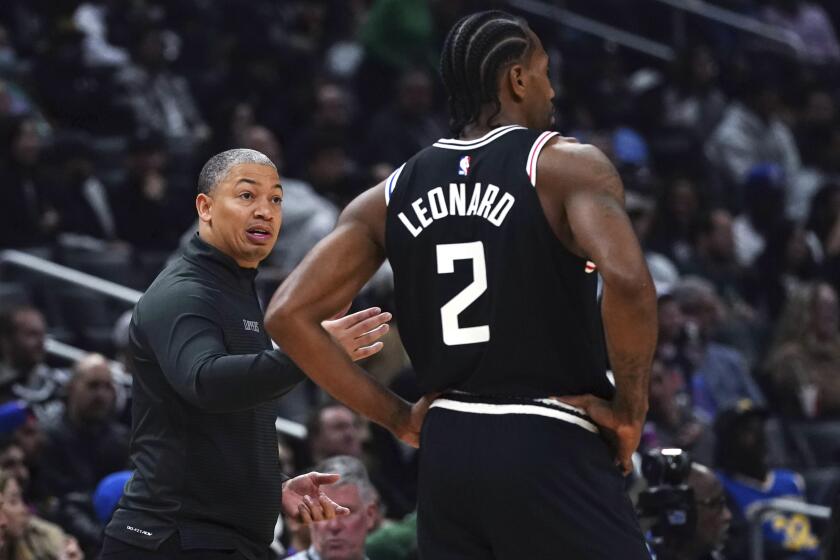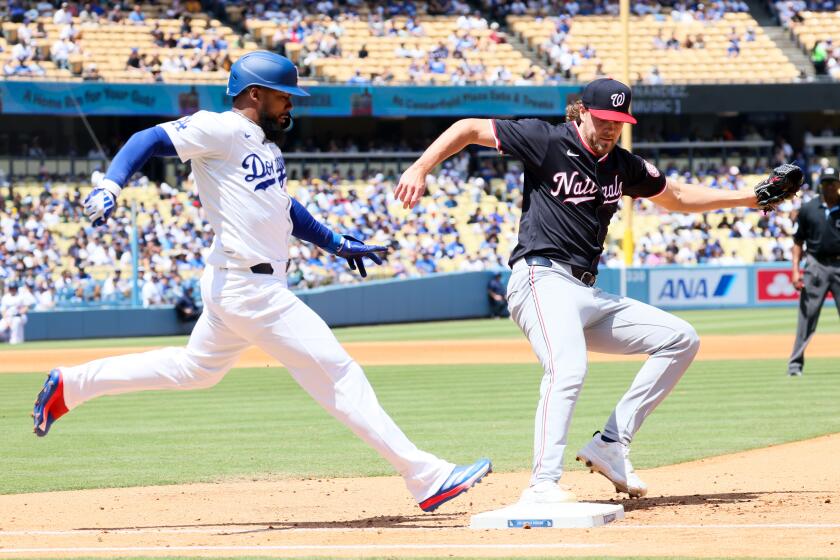USC Aces High
USC will be represented by two aces, Reggie Bush and Matt Leinart, in the top 10 of the NFL draft in the not too distant future, I’d say. Such a distinction doesn’t happen every year. A runner like Bush, who has both rare speed and the rare ability to make hard, fast cuts, is rarely combined with a college passer who has Leinart’s coolness and proficiency under pressure.
That isn’t to say they’ll win the national college championship in the Orange Bowl Jan. 4. To beat an Oklahoma team that’s much improved this year, Leinart will have to put the ball in Bush’s hands much more often. At either running back or wide receiver, Bush can and should be thrown to repeatedly in open land away from the scrimmage line. And he should carry every punt and kickoff.
First down, ideally, is Leinart’s down. There’s less double-coverage then and less heat on passers. On first down, he should throw almost every time.
Second down should belong to Bush. Because of defensive tendencies, it offers the widest selection of running plays.
The defenses that Leinart and Bush will encounter in the NFL and the Orange Bowl feast on first-down runners and on third-down passers. Why give them that glory? Trojan offensive coordinator Norm Chow’s play design promises success to any good players getting smart play selection.
Lovie Smith May Have It All Now
THE CHICAGO BEARS are back in business if — as seems possible now — Lovie Smith has finally found a quarterback: one Chad Hutchinson. When Smith came to the Bears this year as their new head coach after doing the impossible in St. Louis, giving the Rams a defense, he did the same in Chicago, restoring the Bear defense to respectability. He also settled down Chicago’s special teams. But on offense, one Bear quarterback after another has been hurt or faltered or failed. No more.
Hutchinson might not be Chicago’s final answer — he might not even be the answer this week in Jacksonville — but he was clearly the answer in the Minnesota game Sunday, shooting down the Vikings with three touchdown passes, 24-14, and proving to Chicagoland that when Lovie Smith has a quarterback, he has a winner.
Skeptics noted instantly that all three touchdowns were thrown on third down, meaning that Hutchinson was mostly capitalizing on Minnesota’s inept defense. (The NFL’s good defensive teams with their blitzers and tight coverages own third down.) Versus the Vikings, with the game on the line, Hutchinson converted 10 of his first 16 third-down chances, meaning, among other things, that Coach Smith didn’t trust him to throw on first or second down. But if he’s for real, Smith will.
There was a time in Dallas when Hutchinson was going to be the Cowboys’ savior, their new Roger Staubach. Yet he was a baseball pitcher, too, and the St. Louis Cardinals gave him a chance. In time, so did the Cowboy football team, for one unhappy season. He also played football in Europe. When the Bears called, Hutchinson had matured, and Lovie Smith finally had a complete team — for one game at least.
Is Atlanta’s Vick Enough Quarterback?
THE ATLANTA FALCONS will get their second of five chances to clinch a division title this week when the Oakland Raiders come to town. But though the 9-3 Atlanta team owns the NFC South’s sole winning record, it has the look of a team that will lose its first playoff start next month — to anybody.
The Falcon problem is that Michael Vick has furnished little evidence that he’s an instinctively sound quarterback. In a 27-0 loss to division-rival Tampa Bay Sunday, Vick showed again that he can be lit up in the pocket by pass rushers. He’s too small — in particular, he is too short — and he has a vision problem along with an accuracy problem and a confidence problem passing.
His strong arm and his great footspeed — he is by far the swiftest of today’s quarterbacks — often seem to cover up his deficiencies, but they’re always there. For instance, on the Tampa goal line Sunday, Vick threw two interceptions — throwing on either first or second down. Despite the fact that NFL interceptions are wildly overrated, getting so much weight in the league’s passer ratings that they distort the record, a good passer knows better instinctively than to take a chance on an early-down, goal-line interception.
Unless he’s losing in the fourth quarter on third or fourth down, an instinctively alert passer won’t let the ball go toward an end-zone receiver unless his man is clearly open.
The Falcons seem to be one of the NFC’s two standout teams, but in reality there’s only one, Philadelphia. The 15 others — along with half of all AFC teams — are so closely matched that they’re providing Las Vegas with more dead-even propositions every week than you’d see if two dozen strangers were flipping coins.
Running Back Wins Shootout
THE DALLAS COWBOYS used a running back to win a strange 43-39 shootout in Seattle Monday night when rookie Julius Jones ran the last 17 of his 198 yards to score in the last half minute. That took care of the Seahawks, who, it’s beginning to seem, can never win games like this. Although Jones had tipped his hand with a 150-yard nationally televised performance on Thanksgiving Day, that was before the Chicago Bears had come together as a competitive football team.
So the question remains: Is Jones the sensation he seems to be? Or will he fall back to earth when the NFL’s legions of defensive wizards have had a chance to examine him closely? The history of pro football suggests that Jones, a 217-pound, second-round draft choice last April from Notre Dame and Big Stone Gap, Va., will level off.
An earlier, largely unknown running back named Timmy Smith once ran for 200 yards in the Super Bowl but instantly leveled off. Quarterbacks have thrown three or four touchdowns in one quarter of one Super Bowl before leveling off. An unheralded Dallas passer named Clint Longwood beat up on the heavily favored Los Angeles Rams one day long ago and was never heard from again. On the 2004 Dallas team, though, Jones looks as if he can be, at the least, a formidable force. Although the NFL is packed with superior defensive coaches, he beat one of the best of them, Ray Rhodes, in Seattle.
Will Tomlinson Trouble Chargers?
THE SAN DIEGO CHARGERS seem to be on top of the world this week as well as the AFC West, but they may be heading for trouble in the season’s last month, starting with the Tampa Bay game this week in San Diego. Trouble has returned to the Chargers in the form and person of their running back, LaDainian Tomlinson, who, after an injury, is about ready to blast off.
To win nine times in their first 12 games this fall, the Chargers typically attacked with quarterback Drew Brees’ passes. But they ran Tomlinson on power runs Sunday often enough to keep Brees from defeating Denver decisively. In a close one that San Diego won, 20-17, the Chargers demonstrated — first of all — that if they start attacking now with Tomlinson, that could be the last game they win for a while.
For, as a running back, Tomlinson is most useful as a second-down counterpuncher after Brees has opened with first-down passes. The reason the Chargers have surprised the league this year is that they’ve let Brees open up.
Their offensive coordinator Cam Cameron still had Brees and Tomlinson in their best formation some of the time Sunday — a one-back three-wide-receiver set that suits both stars. It gives Brees an extra receiver to throw to — most helpfully on first down — and it clears running room for Tomlinson, who, like all great backs, needs open space more than he needs a fullback blocking.
San Diego’s Coach Marty Schottenheimer is, however, an old-time conservative who likes to win with defensive strength and offensive power — defining a power run as one with a blocking back, usually a fullback, or an extra tight end, or both. In a passing era, in what has become a passing league, that won’t do it. In Schottenheimer’s preferred football, a revived Tomlinson is more danger than asset to San Diego.
Football’s One Great Formation
HERE’S WHAT Cameron’s one-back three-receiver formation did to Denver Sunday to get the go-ahead touchdown for San Diego. On first and goal, an incomplete pass reminded the Broncos that they were up against a passing formation. When the Chargers came out in the same formation on second and third downs, they confused Denver with handoffs to Tomlinson, who ran the ball in easily. That’s counterpunching.
It was an easy touchdown for a gifted ballcarrier because, when the Chargers lined up with three wide receivers and only one back, Denver, fearing Brees, sent in a fifth defensive back and removed a linebacker.
That meant Tomlinson faced, instead of a big-muscled linebacker, a smaller pass-defense specialist who, what’s more, had to line up far away from the hole Tomlinson hit.
Put another way, Tomlinson was facing only six Broncos along the line of scrimmage instead of seven. As the play started, Tomlinson, a good reader as well as an effective option runner, could tell which two of his offensive linemen were, together, most efficiently blocking out two of the six defensive linemen. And he simply hit that hole.
All that is why, on the goal line, the best running-play formation is also the best passing formation — the set with an extra wide receiver instead of a fullback.
To conservative coaches, the best goal-line formation is something else. For decades, they’ve chosen to attack with two tight ends and a blocking fullback. What that principally does, though, is pile up big bodies in the way of their running back — big offensive bodies plus big defensive bodies. In numerous games this year, including the Monday night shootout this week, you’ve seen running backs fail on third and one. That’s why.
The truth is that the Chargers will lose some key games this year — as they’ve lost with Tomlinson in other years — if they keep sending him into the line on power runs. When, instead, they’re playing offensive football with one back and three wide receivers, the Chargers are more likely to succeed with passes by Brees and with Tomlinson counterpunching on second down.
More to Read
Get our high school sports newsletter
Prep Rally is devoted to the SoCal high school sports experience, bringing you scores, stories and a behind-the-scenes look at what makes prep sports so popular.
You may occasionally receive promotional content from the Los Angeles Times.






